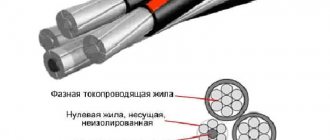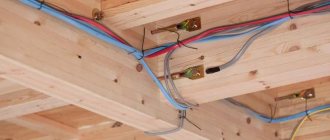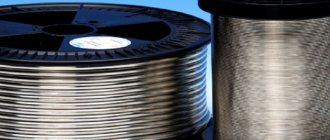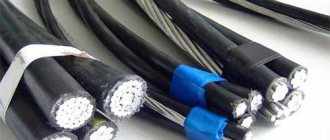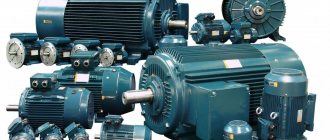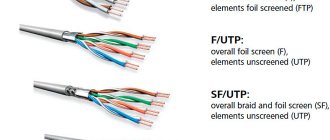What is SIP-2 cable (decoding)
The abbreviation SIP stands for this:
- C – self-supporting (that is, not requiring additional suspension);
- I – isolated;
- P – wire.
Support with SIP wire
The last symbol emphasizes the difference from a cable, since SIP can be used as a replacement for existing power supply wires without changing the design of the electrical network.
Next may be symbols that indicate additional insulation characteristics:
- n – non-flammable;
- g – sealed.
The hyphen is followed by a number from 1 to 5, which indicates the type of SIP wire. The symbol “H” after the number indicates that its alloy is used instead of aluminum.
Numerical symbols after the letter designation characterize the number of cores and their cross-section.
If the wire contains additional lighting cores, their number and cross-section are indicated with a plus sign.
Example notation:
SIP-2N 4x25+2x10-0.4
Explanation:
Self-supporting wire type 2. Contains four main wires with a cross-section of 25 mm2 and two lighting wires with a cross-section of 10 mm2. The number 0.4 characterizes the voltage class. In this case, 0.4 kV. The cores are made of aluminum alloy.
The SIP-2A wire has similar technical characteristics, except that cross-linked polyethylene is used as insulation.
Wire SIP-2 3x35+1x54.6+1x16
Note! In accordance with industry and internal standards, each manufacturer has the right to make additions to the labeling that characterize the features of its products.
How to install a self-supporting insulated wire
To install this type of cable and wire products, it is first necessary to secure the hooks to the overhead line supports. It looks like this:
These hooks are secured using bandage tape and yokes. The bandage tape is secured to the support using a special device for installing SIP, which is also shown in the top photo.
After the hooks are attached, special rollers are attached to them. The result should be the following construction:
Next, you need to connect the leader cable to the SIP wire and pass the cable through the rollers.
After the cable is pulled, you can stretch the SIP cable. This is usually done using a winch as shown in the top photo.
Important! If the distance between the supports is large, then it is recommended to install 2 anchor clamps for SIP on each support. Also, 2 anchor clamps must be installed when turning lines in order to evenly distribute the load on the supports.
In cases where the SIP wire consists of several sections, then their connection is made using special sleeves for pressing:
Cable Specifications
The rated voltage of the SIP wire depends on the thickness of the insulation and ranges from 0.22 to 32 kV. The current load is determined by the cross-sectional area of the current-carrying conductors.
Main technical characteristics:
- Operating temperature range from -60°С to +50°С;
- Permissible installation temperature without preheating is -20°C;
- Core cross-section 16 – 150 mm2
- The minimum bending radius during installation and operation is 10 Ø;
- Permissible long-term core temperature: during operation 70-90°C, during short circuit 135-250°C;
- Warranty period 5 years;
- Technical service life is at least 45 years.
The permissible current load at an ambient temperature of +25°C, a wind speed of 0.6 m/s and a solar radiation level of 1000 W/m2, as well as a short circuit current operating for 1 second, are shown in the table below.
You may be interested in Description of the MKESH cable
| Cross-section of current-carrying conductors, mm2 | Permissible continuous load current, A | Short circuit current, A |
| 16 | 76 | 870 |
| 35 | 160 | 3200 |
| 50 | 195 | 4500 |
| 70 | 240 | 6500 |
| 95 | 300 | 8800 |
| 120 | 340 | 10900 |
The insulation of each core is distinctly color-coded with a colored stripe on a black background. Instead of color there may be raised stripes.
Raised markings
The cable cores are made of stranded aluminum. As a rule, one of the wires (central) in the load-bearing core is made of steel. This core takes on the load when hanging the wire between the supports. The cores are compacted during the manufacturing process and have a round cross-section.
Sectional view of the cable
In some cases, instead of pure aluminum, its alloy with other metals is used to increase mechanical strength.
The main advantages of SIP wires are as follows:
- The fundamental impossibility of phase overlap with subsequent short circuit;
- Smaller right-of-way (clearing width);
- Reduced losses by reducing reactance;
- Reducing the load on power line supports (especially during icy periods);
- No need to use insulators;
- Making illegal connections difficult;
- Reduced operating costs.
The main requirements for an insulating coating are resistance to ultraviolet radiation and the ability to operate in a wide temperature range. Light-stabilized low-density polyethylene (LDPE) or light-stabilized cross-linked polyethylene (XLPE) meets these requirements.
To attach wires to load-bearing surfaces or supports, special anchor and support clamps and hooks are used. To connect or install bends, cutting and stripping of insulation is not required, since piercing clamps are used.
Note! The use of specialized mounting hardware increases installation costs, but improves the quality of work and reduces the cost of ongoing operation of the electrical network.
Correction factors
| Temperature of the conductor, ° C | Correction factors at ambient temperature, ° C | ||||||||||
| 10 | 15 | 20 | 25 | 30 | 35 | 40 | 45 | 50 | 60 | 75 | |
| 90 | 1,17 | 1,13 | 1,09 | 1,04 | 1,00 | 0,95 | 0,91 | 0,85 | 0,80 | 0,67 | 0,52 |
Types of SIP-2 cable
Manufacturers produce five types of SIP wires, which differ in the number and type of current-carrying cores and the method of insulation:
- SIP-1. It consists of five insulated phase conductors and one non-insulated one, which is zero (neutral). This same core is the load-bearing wire, since the central wire in it is made of mild steel.
- SIP-2. Completely similar to the first, except that the neutral core is also covered with an insulating sheath.
- SIP-3. The only wire with a single core. Used for installation of high-voltage power lines.
- SIP-4. Contains one or two pairs of cores insulated with thermoplastic polyethylene. There is no null or supporting core.
- SIP-5. It differs from the previous one in the type of insulation that uses cross-linked polyethylene.
You might be interested in: Features of heat shrink tube
With uninsulated neutral core
Only one type of wire has an insulated neutral core - SIP-1. During normal operation of a three-phase network, the current and potential of the neutral conductor are close to zero, so there is no need to isolate it. The use of SIP-1 wire with a non-insulated load-bearing core can provide some economic effect and reduce the load on the hangers by reducing the weight of the cable.
Wire SIP-1
With insulated neutral core
Fully insulated wire type SIP-2 is universal and suitable for use in networks with unevenly loaded phases. The zero (neutral) conductor, covered with insulation, provides an additional level of safety during operation and maintenance.
Wire SIP-2
Without zero load-bearing core
For wiring subscriber electrical networks and making taps to single-phase devices, paired cables of types SIP-4 and SIP-5 are used, which do not have a separate load-bearing core. All cores in such a cable are completely similar to each other.
Wire SIP-4
Important! Due to the fact that the permissible mechanical load on such a cable is lower, its use is limited by the maximum span between the fasteners.
In wires without a neutral core, any wire can be used, subject to appropriate marking.
Where is SIP-2 cable used (purpose)
A wire with an insulated neutral SIP-2 is used in networks with a rated voltage of up to 1 kV. This type is the main one in areas with a humid climate and a high salt content in the atmosphere. These are coastal areas, saline soils, and industrial areas.
This type of wire is also used when there are increased requirements for electrical safety and reliability.
How is the connection to the SIP wire made?
After the self-supporting insulated wire is completely laid along the supports, a connection is made to the lighting circuits (lanterns on poles, LED spotlights, etc.) and to household consumers (houses, cottages, office premises, and so on). This process is performed using special clamps, which come in 2 types:
- Insulated (sealed);
- Non-insulated.
The result of the work performed should be the following:
How to choose the right SIP-2 cable (cable cross-section)
The choice of wire cross-section is based on the current strength of the consumers, as well as possible overload currents. When taking into account overload capacity, the following standards should be taken into account:
- The duration of overloads should not exceed 8 hours a day;
- The total operating time with overload should not exceed 100 hours per month;
- The total operating time with overload for the full service life should not exceed 1000 hours.
The conclusion suggests itself is that to ensure uninterrupted and safe operation, you can use a wire with a larger cross-section. This is incorrect because it is not economically justified due to the high cost of the material.
A more complete and accurate calculation should take into account the type of cable insulation, since thermoplastic polyethylene has worse performance characteristics than cross-linked polyethylene, especially the permissible operating temperature (70°C versus 90°C).
The following is taken into account:
- The permissible load current of a wire with thermoplastic polyethylene insulation is 1.1 - 1.2 times less than that of cross-linked polyethylene.
- The cost of the latter is 1.3 – 1.4 times higher.
Thus, in many cases it is more advisable to use a thinner, but also more expensive wire with cross-linked polyethylene insulation. Reduced requirements for supports and fastening equipment (due to the lower mass of wires) and the higher durability of cross-linked polyethylene also contribute to the economic effect.
You might be interested in VVG GOST wire
Design parameters of current-carrying conductors
| Nominal cross-section of current-carrying conductor, mm2 | Number of wires in the core, pcs. | Outer diameter of current-carrying core, mm | Nominal insulation thickness, mm, for wires of brands SIP-2, SIP-2A | Electrical resistance of 1 km of wire, Ohm, no more | ||
| phase | control | minimum | maximum | |||
| 16 | — | 1 | 4,35 | 4,45 | 1,3 | 1,91 |
| 16 | — | 7 | 4,60 | 5,10 | 1,3 | 1,91 |
| 25 | — | 7 | 5,70 | 6,10 | 1,3 | 1,20 |
| 35 | — | 7 | 6,70 | 7,10 | 1,3 | 0,868 |
| 50 | — | 7 | 7,85 | 8,35 | 1,5 | 0,641 |
| 70 | — | 7 | 9,45 | 9,95 | 1,5 | 0,443 |
| 70 | — | 12 | 9,70 | 10,20 | 1,7 | 0,443 |
| 95 | — | 7 | 11,1 | 11,7 | 1,7 | 0,320 |
| 95 | — | 19 | 11,0 | 12,0 | 1,7 | 0,320 |
| 120 | — | 19 | 12,50 | 13,10 | 1,7 | 0,253 |
| 150 | — | 19 | 13,90 | 15,0 | 1,8 | 0,206 |
| — | 1,5 | 1 | — | 1,5 | 1,2 | 12,1 |
How to store and transport SIP-2 cable
Like most manufactured cable products, in accordance with GOST, SIP cable is transported and stored exclusively in wooden drums. A tag indicating the length brand and production date of the product is attached to the inside of the drum cheek.
Drum with cable
In some cases, short-term storage in bays is permitted subject to the following conditions:
- The cable cross-section is in the range of 16 – 25 mm2;
- The total weight of the bay does not exceed 25 kg.
Transportation and storage of products must provide protection from direct contact with precipitation. Short-term storage outside sheds or enclosed spaces is possible.
Important! During long-term storage, cable drums must be installed vertically.
Manufacturers of cable SIP-2
Excellent performance qualities and high demand have led to the fact that SIP brand wire is produced by most manufacturers of cable and wire products.
There are several manufacturers who can be called leading, and whose products are in high demand.
"Kama cable"
"Kamkabel" is a leader among manufacturers in Russia and the CIS countries in terms of volumes of products produced and sold. In the range of self-supporting cables you can find all types of SIP wires from 1st to 5th of all permissible sections for use in all areas of the electrical power industry.
Kama cable
"Rybinskkabel"
The main directions of the policy of the Rybinsk Cable Plant are competitive prices for products and guaranteed product quality, confirmed by numerous certificates.
The range also includes the entire line of SIP wires, both by type of insulation and cross-section of conductors.
Rybinskcable
GC "Sevkabel"
The St. Petersburg enterprise “Sevkabel” is the oldest in the industry and was organized back in 1879 by Georg Siemens. Since the start of operation, the company has been distinguished by the highest level of production culture. This characteristic has a positive effect on the quality of the products.
In addition to the main types, the plant produces SIP-7 cable, which is rarely used in the post-Soviet space, intended for 110 V electrical networks.
Sevkabel
"Moskabel"
Moscow enterprise for the production of cable and wire products from copper and aluminum wire. The range includes both classic non-insulated aluminum and SIP wires of all types.
Moscabel
In addition, there are more than ten domestic manufacturers of similar products.
The use of self-supporting wires is advisable not only when building new lines or connecting objects. High performance, reliability and durability are the reason for the gradual and widespread replacement of outdated non-insulated aluminum wires.

